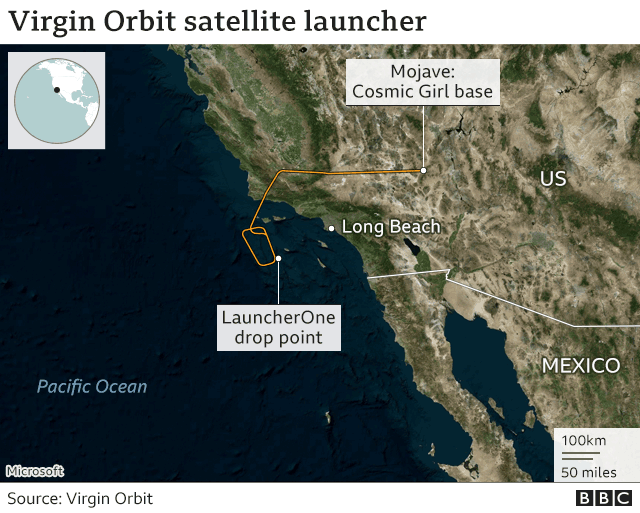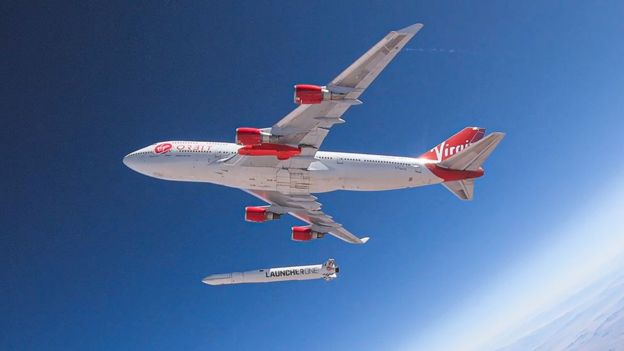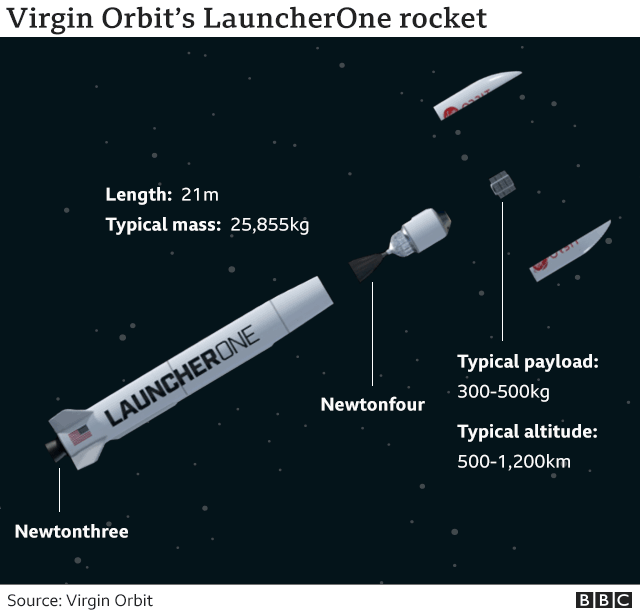21.05.2020

British businessman Sir Richard Branson is looking to this weekend to debut one of his new space systems.
Virgin Orbit, based in California, will put satellites above the Earth, using a rocket that's launched from under the wing of a jumbo jet.
The maiden mission, to be conducted out over the Pacific Ocean, could take place as early as Saturday.
Assuming this demonstration is successful, Virgin Orbit hopes to move swiftly into commercial operations.
It already has a rocket built at its Long Beach factory for a second mission.

There is an emerging market for small, lower-cost satellites, whose developers are seeking more flexible and affordable ways of getting their assets into space.
Virgin Orbit is one of a number of companies now racing to meet this demand. Other contenders include the Rocket Lab outfit, which sends up its vehicles from a ground launch pad in New Zealand; but there are tens of other small rocket start-ups at various stages of development.
Sir Richard had originally planned to run his satellite-launch business as part of his tourist spaceplane venture, known as Virgin Galactic, but decided eventually to split the projects into separate entities.
The businessman will not be in California at the weekend to witness the demonstration. He'll be following events remotely.
 Image copyrightVIRGIN ORBIT
Image copyrightVIRGIN ORBIT
Virgin Orbit engineers will only proceed with the test mission if the weather over the Pacific launch zone is favourable.
If it is, the former Virgin Atlantic jumbo, now named Cosmic Girl, will carry the rocket, dubbed LauncherOne, to an altitude of about 35,000ft (10km), where it will drop the liquid-fuelled booster into a freefall.
Roughly four seconds into that fall, as Cosmic Girl banks hard to the right, LauncherOne will ignite its Newton Three engine to begin the climb to orbit. The dummy payload atop the rocket's upper-stage will be released after 32 minutes.

The company is trying to dampen too much expectation. Maiden flights of rockets quite often discover unforeseen technical shortcomings and fail.
"That's what the history of rockets tells us and we're ready for that, but we'll see how far we get," Will Pomerantz, Vice President of Special Projects at Virgin Orbit, said. "As soon as that Newton engine ignites, we'll be learning," he told BBC News.
The company had hoped to run this campaign earlier in the year but like all businesses has had to contend with coronavirus complications. Indeed, part of the Long Beach factory has been turned over to making ventilators for use in hospitals.
Currently, flight operations are being run out of the Mojave Air and Space Port to the north of Los Angeles. But Virgin Orbit expects at some point to offer launches to customers in different locations around the world.
Sir Richard and the British government have spoken of using Newquay in southwest England as a potential base.
Quelle: BBC
----
Update: 23.05.2020
.
Virgin Orbit schedules its first orbital test launch this weekend

The first orbital test flight of Virgin Orbit’s privately-developed air-launched rocket is scheduled as soon as Sunday off the coast of Southern California, the company said Wednesday.
Designed to deliver small satellites into orbit, the LauncherOne vehicle has a four-hour window Sunday opening at 10 a.m. PDT (1 p.m. EDT; 1700 GMT) to head into space after release from the belly of Virgin Orbit’s Boeing 747 carrier aircraft. A backup launch opportunity is available at the same time Monday.
“We will only proceed with the mission if all conditions for launch are nominal,” Virgin Orbit said in a press kit for the demonstration flight. “Although air-launched systems like ours are less vulnerable to bad weather than fixed ground-launch systems, we’ll be watching the weather closely and being cautious for this maiden flight.”
Virgin Orbit announced the target launch date Wednesday as the company nears the final phase of an eight-year development effort that began as a spinoff of sister company Virgin Galactic, which focuses on the suborbital space tourism market.
Both companies are part of Richard Branson’s Virgin Group. The LauncherOne vehicle aims to become the first liquid-fueled air-launched rocket to reach orbit.
Virgin Galactic says it first studied the LauncherOne concept in 2007, and development began in earnest in 2012. Engineers in 2015 scrapped initial plans to drop the rocket from Virgin Galactic’s WhiteKnightTwo carrier aircraft, and kicked off development of a redesigned system using a 747 jumbo jet taken from Virgin Atlantic’s commercial airline fleet.
Headquartered in Long Beach, California, Virgin Orbit was established in 2017 as a spinoff of Virgin Galactic.
“This Launch Demo marks the apex of a five-year-long development program,” Virgin Orbit said in a statement. “On our journey to open up space for everyone, we’ve conducted hundreds of hotfires of our engines and our rocket stages, performed two dozen test flights with our carrier aircraft, and conducted countless other tests of every bit of the system we could test on the ground.”
In the last six weeks, Virgin Orbit completed a captive carry test of the LauncherOne rocket. Teams filled the vehicle with kerosene fuel and cryogenic liquid nitrogen, a stand-in for liquid oxygen used as an oxidizer during a real launch, and the 747 carrier aircraft — named “Cosmic Girl” — took off from Virgin Orbit’s flight operations base at the Mojave Air and Space Port in California.
Virgin Orbit exercised propellant loading, takeoff, tracking and telemetry, and return-to-base procedures during the captive carry test April 12. The company completed additional rehearsals on the ground in recent weeks, practicing filling and draining the rocket’s supply of kerosene and liquid oxygen.
Now the rocket is ready to fly, Virgin Orbit said this week.

Dan Hart, Virgin Orbit’s CEO, told Spaceflight Now last month the LauncherOne’s first flight will carry some “test payloads” the company developed. He said Virgin Orbit will release details about the payloads on the inaugural launch at a later time.
Hart characterized the first flight as “an engineering test.”
“Of course, we would love it to get to orbit,” Hart told Spaceflight Now. “The more of the system that we can exercise, the more confidence that we’ll have for the next flight. We do know, and we’re mindful, that a first flight is not without risk.”
“We’re mindful of the fact that for the governments and companies who have preceded us in developing spaceflight systems, maiden flights have statistically ended in failure about half of the time,” Virgin Orbit said in a statement Wednesday.
“In the future, the goal of our launches will be to deploy satellites for a new generation of space-based services,” the company said. “For this Launch Demo, though, our goal is to safely learn as much as possible and prove out the LauncherOne system we’ve worked so hard to design, build, test and operate.”
Piloted by Kelly Latimer, Virgin Orbit’s chief test pilot, the 747 carrier aircraft will line up for its launch run west of San Nicolas Island, which is owned by the U.S. Navy. The targeted drop point is located roughly 100 miles (160 kilometers) west-southwest of Long Beach.
Latimer will command the airplane onto climb angle of more than 25 degrees. The nearly 30-ton rocket will be released from a pylon under the 747’s left wing during the pull-up maneuver at an altitude of around 35,000 feet (nearly 10,700 meters).
Around five seconds after release, the rocket’s kerosene-fueled NewtonThree engine will ignite with 73,500 pounds of thrust to begin climbing into orbit.
“The instant our NewtonThree engine ignites, we will have done something no one has ever done before — lighting an orbital-class, liquid-fueled, horizontally-launched vehicle in flight,” Virgin Orbit said.
“We’ll continue the mission for as long as we can,” the company said. “The longer LauncherOne flies, the more data we’ll be able to collect. Should we defy the historical odds and become one of those exceedingly rare teams to complete a mission on first attempt, we will deploy a test payload into an orbit, take our data, and then quickly de-orbit so as not to clutter the heavens.”
If everything goes as Virgin Orbit hopes, the company intends to restart the second stage’s NewtonFour engine once in space, validating the rocket’s ability to deliver payloads to different orbits on the same mission.
The mission profile for the first LauncherOne flight lasts 32 minutes from the time of the rocket’s release from the “Cosmic Girl” jumbo jet until separation of its payload in orbit.

The 70-foot-long (21-meter) LauncherOne rocket is designed to compete with other commercial smallsat launchers, such as Rocket Lab’s Electron booster, for contracts to deliver CubeSats and microsatellites to orbit for commercial customers, the U.S. military and NASA. Virgin Orbit says it can haul up to 660 pounds (300 kilograms) of cargo into a 310-mile-high (500-kilometer) polar sun-synchronous orbit, a standard operating orbit for Earth-imaging satellites.
A dedicated launch by Virgin Orbit sells for around $12 million.
Hart said last month that Virgin Orbit plans to have a chase plane for the launch, and video cameras are mounted on the aircraft and the the LauncherOne vehicle itself to capture the rocket’s release from the carrier jet, first stage ignition and climb into space.
But the company does not plan to provide a live public webcast for the LauncherOne demonstration flight. Instead, Virgin Orbit will release updates on Twitter as the mission progresses.
Quelle: SN
----
Update: 25.05.2020 / 16.30 MESZ
.
Our team has worked diligently to resolve the sensor issue and recycle the system. We’re now back in the countdown, and are currently targeting another launch attempt tomorrow, with our window again open from 10 AM to 2 PM Pacific (17:00 – 21:00 UTC).




Quelle: Virgin Orbit
+++
Update: 21.45 MESZ
.
Good morning, world! Today is a momentous occasion for the Virgin Orbit team: operations for the first orbital launch demonstration of our LauncherOne rocket are well underway.


Update for Monday, May 25: Virgin Orbit is now targeting its first LauncherOne launch for May 25 between 10 a.m. and 2 p.m. PDT (1-5 p.m. EDT/1700-2100 GMT). Our original delay story is below.
Virgin Orbit postponed the launch debut of its new rocket for small satellite missions today (May 24) due to a sensor glitch on the booster.
The rocket, an air-launched vehicle called LauncherOne, was expected to make its first test flight over the Pacific Ocean during a four-hour window that opened at 10 a.m. PDT (1 p.m. EDT/1700 GMT). But after fueling the rocket late Saturday, an issue popped up.

Quelle: Virgin Orbit
----
Update: 26.05.2020
.


Mojave, California — May 25, 2020 — Virgin Orbit, the California-based satellite launch company, conducted a launch demonstration of its innovative air-launched rocket today in the skies over the Pacific Ocean just off the California coast. The company successfully completed all of its pre-launch procedures, the captive carry flight out to the drop site, clean telemetry lock from multiple dishes, a smooth pass through the racetrack, terminal count, and a clean release. After being released from the carrier aircraft, the LauncherOne rocket successfully lighted its booster engine on cue — the first time the company had attempted an in-air ignition. An anomaly then occurred early in first stage flight, and the mission safely terminated. The carrier aircraft Cosmic Girl and all of its crew landed safely at Mojave Air and Space Port, concluding the mission.
“Our team performed their prelaunch and flight operations with incredible skill today. Test flights are instrumented to yield data and we now have a treasure trove of that. We accomplished many of the goals we set for ourselves, though not as many as we would have liked,” said Virgin Orbit CEO Dan Hart. “Nevertheless, we took a big step forward today. Our engineers are already poring through the data. Our next rocket is waiting. We will learn, adjust, and begin preparing for our next test, which is coming up soon.”
The company’s next rocket is in final stages of integration at its Long Beach manufacturing facility, with a half-dozen other rockets for subsequent missions not far behind. Virgin Orbit’s decision to begin production of multiple rockets well in advance of this test flight will enable the team to progress to the next attempt at a significantly faster pace, shortly after making any necessary modifications to the launch system.
Quelle: Virgin Orbit
